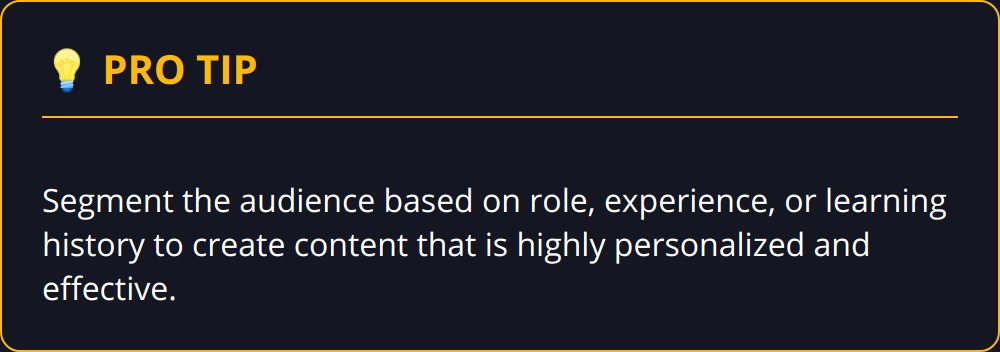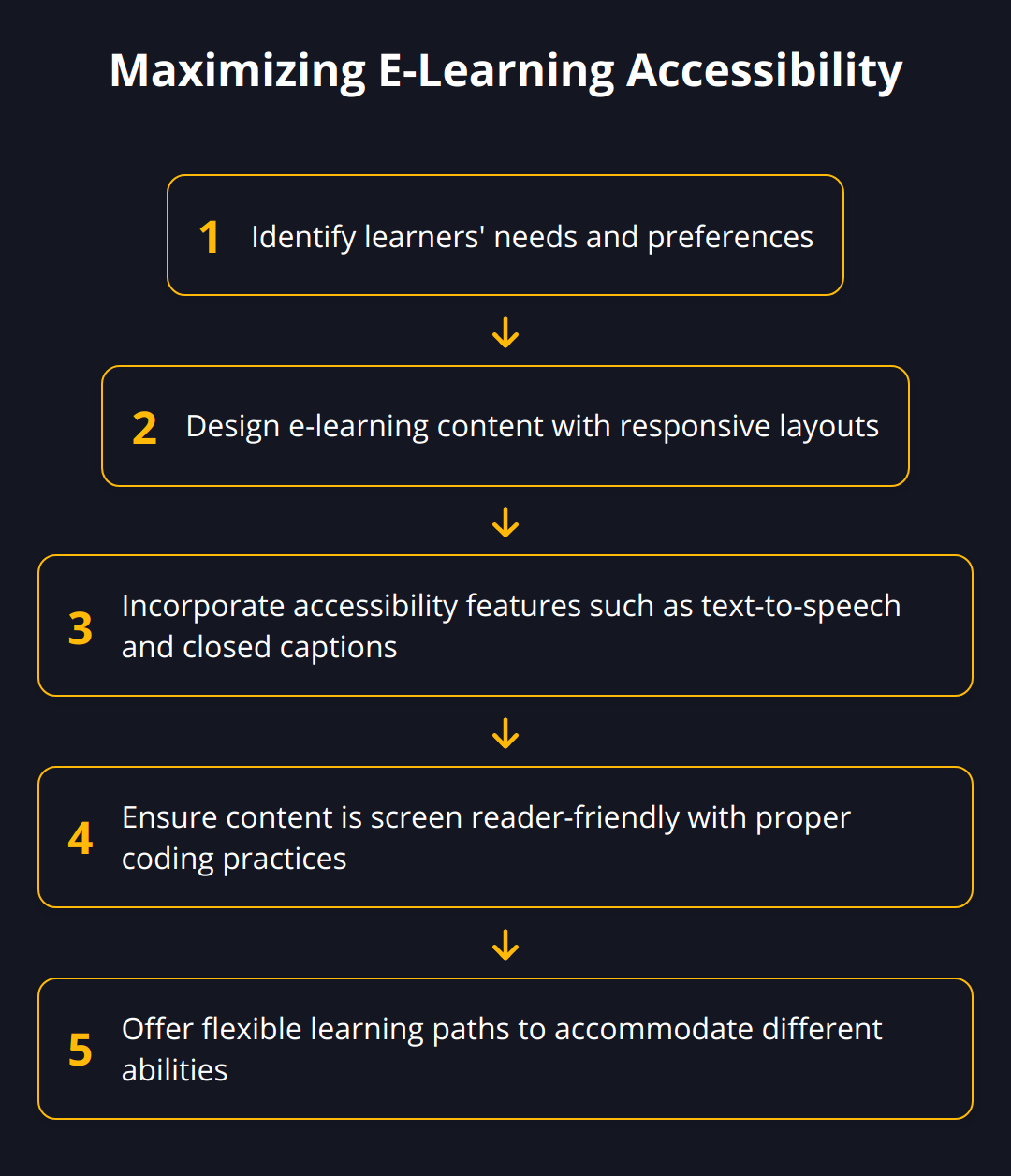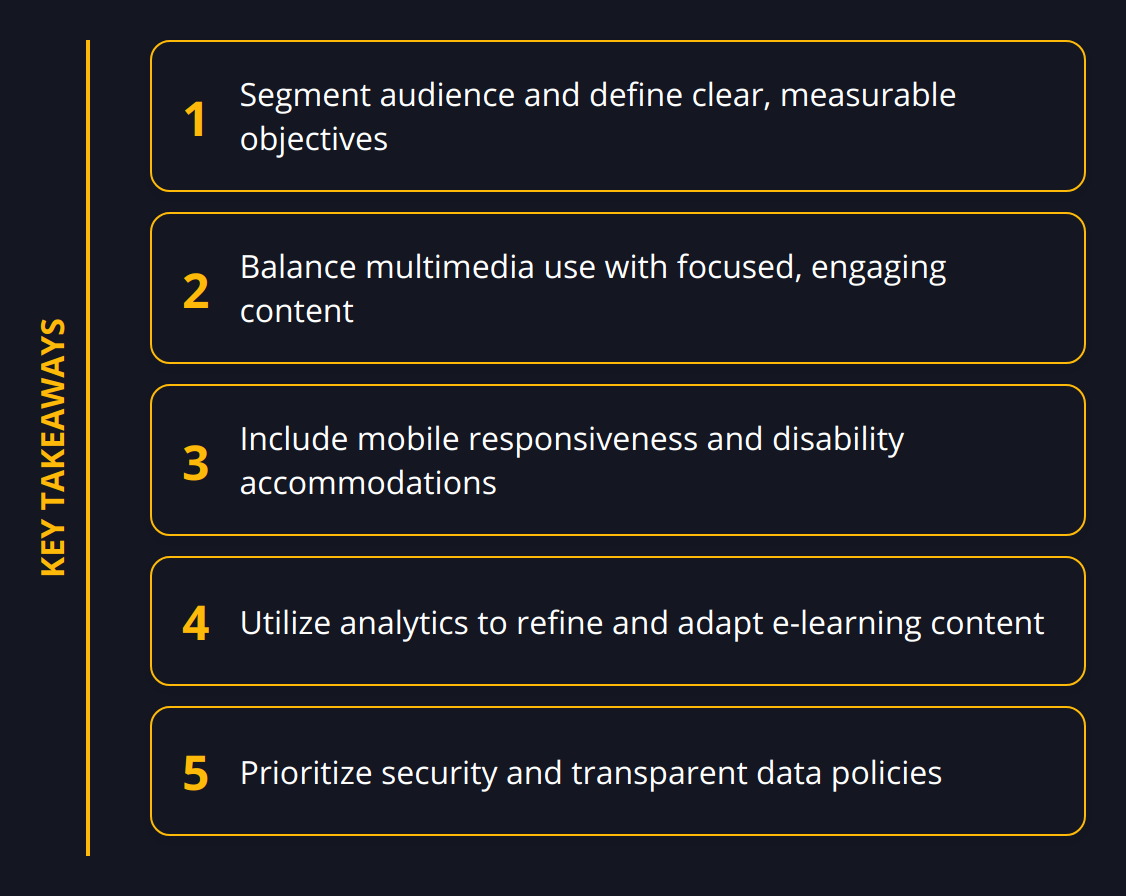We at Newroom Connect understand that the landscape of e-learning is constantly evolving. To stay ahead, developers must craft content that not only educates but also engages and adapts to the diverse needs of learners.
In the following guide, we unveil best practices that will elevate your e-learning content, ensuring it’s effective, inclusive, and reflective of the latest advancements in digital education. These strategies are grounded in extensive research and proven methodologies to enhance learning experiences.
Identifying Your Learners and Setting Clear Goals
When developing eLearning content, understanding who your learners are is a foundational step. Knowing your audience provides the framework for tailored content that resonates with them. It is essential to conduct an in-depth analysis of learner demographics, professional backgrounds, and technological proficiencies. This data not only informs the content’s complexity but also indicates the most effective delivery methods.
Pinpointing your learners’ needs is not about guesswork; it’s about precision. Consider surveys or consult with front-line managers to gain insights into the participants’ daily challenges and learning preferences. It is this attention to detail that turns good eLearning material into great ones. By incorporating examples relevant to their jobs, you can make the learning experience realistically applicative and incredibly more engaging.
Another cornerstone is the alignment of learning objectives with business goals. Weakly defined objectives are the bane of any instructional design. Set clear, measurable learning outcomes that reflect organizational aims. An instructional designer must ask, “What should the learner be able to do post-course that they couldn’t beforehand?” This clarity helps to focus the course and measure success post-implementation.

Here are some actionable steps:
-
Segment the audience based on role, experience, or learning history to curate content that fits like a glove.
-
Define SMART objectives to lend clarity and purpose to each module. These should be Specific, Measurable, Achievable, Relevant, and Time-bound.
-
Revisit the data. Use analytics tools to continually align content with real-time feedback and outcomes.
It’s important to stress the significance of measurable outcomes. The allure of qualitative feedback should not overshadow quantitative data’s critical role. Test scores, completion rates, and post-training performance metrics offer invaluable insights into your content’s efficacy.

Remember, eLearning is not a static endeavor. As learner profiles evolve, so too should the content. It’s not just about ticking off boxes but fostering a culture of continuous, impactful learning. A meticulously crafted eLearning program, designed with the learner at its heart, remains paramount in achieving long-term educational success.
Discover more about the intricacies of eLearning with our guide on analyzing attendee feedback, where we explore how to best utilize learner insights for content development. Additionally, grasp the essentials of adaptive eLearning strategies by reading about boosting learner engagement. These resources are pivotal in molding effective digital learning environments.
Crafting Dynamic E-Learning Experiences
To keep learners captivated, e-learning courses should burst with interactivity and engagement. Learners today expect dynamic, not static, learning experiences. The use of multimedia enriches the learning environment, while simulations and storytelling transform passive content consumption into an active adventure.
Multimedia Integration is vital—blend text, images, audio, and video to cater to various learning preferences. The trick lies in balance; too little fails to engage, too much can overwhelm. Videos should be concise, with a recommended length of 2-7 minutes for optimal engagement. High-quality, relevant images can break up text and maintain interest, while infographics can distill complex information into digestible visuals.
Simulations offer an immersive way for learners to practice real-world scenarios without real-world stakes. For example, customer service training can be revolutionized with branching scenarios, allowing learners to navigate through conversations with virtual customers, making decisions that affect outcomes. Real-time feedback helps cement learning, turning theory into practical skill.

Storytelling can be a powerful tool, providing context and emotional connection. Narratives that reflect learners’ job realities foster empathy and retention. Integrating a strong story arc in courses can guide learners through content with greater interest.

Gamification takes motivation to a new level. Integrating game mechanics—such as points, badges, and leaderboards—spirits learners away from the tedium of traditional learning. A study by the University of Colorado found that gamification boosted skill-based assessments by 14% and fact-based knowledge by 11%. Gamification also spurs friendly competition and offers tangible goals, boosting engagement and retention.
Microlearning modules are not just a trend; they’re a response to our modern work-life rhythm. Bite-sized learning pieces—typically 3-5 minutes long—fit neatly into busy schedules. The ability to complete a module between meetings or during a commute introduces flexibility without sacrificing depth. For instance, sales training can be broken down into micro-modules focusing on different stages of the sales process. The result? Information that sticks and is readily applied.
When designing content, here are a few essential pointers:
-
Quality over quantity: Avoid clutter. Well-chosen multimedia beats an abundance of mediocre resources.
-
Interactivity is key: Use quizzes, drag-and-drop activities, and scenario-based assessments to transform passive learners into active participants.
-
Story matters: Weave a narrative thread through your courses to keep learners intrigued and invested.
-
Reward progress: Apply game principles wisely to encourage a sense of achievement and recognition.
-
Respect time boundaries: Create modules that respect the learner’s time while delivering value.
Pioneering e-learning methods empower us to create content that’s not merely informative but transformative. Through well-thought-out design and technology utilization, we can revolutionize how knowledge is consumed and retained. Engaging and interactive courses are the hallmark of forward-thinking e-learning development.
Feel free to explore the benefits of digital showrooms for practical insights on using virtual spaces to enhance learning and engagement. Additionally, consider how immersive technologies can take your e-learning to new heights by reading our comprehensive guide on e-learning VR integration. These resources are instrumental in creating next-generation e-learning environments.
Maximizing E-Learning Accessibility
Ensuring that e-learning content is accessible for all learners is not just beneficial—it’s imperative. Adopting a universally inclusive approach is both a legal requirement and a mark of a quality educational program.
Designing with mobility in mind is a non-negotiable. With smartphones accounting for 54.8% of global website traffic, it’s clear that mobile accessibility is not an option, but a necessity. Responsive design ensures that e-learning modules fluidly adapt to screens of all sizes, maintaining functionality and aesthetics across devices. To achieve this, prioritize simplicity in layout and navigation, making use of collapsible menus and tappable icons that enhance the mobile learning experience.
Accessibility for individuals with disabilities must be given equal attention. Learners may have visual, auditory, motor, or cognitive challenges that require specific adjustments. Use alt text for images, provide transcripts for audio, ensure keyboard navigability, and design with contrast sensitivity in mind. Incorporating these features doesn’t just meet compliance standards; it exemplifies an inclusive mindset.
Here are practical tips to enhance accessibility:
-
Implement text-to-speech functionality to aid visually impaired learners.
-
Use closed captions and subtitles for videos and audio clips.
-
Leverage screen reader-friendly content, with proper HTML headers and readable fonts.
-
Incorporate flexible learning paths that allow learners to choose their journey based on their abilities.

Content security and privacy are another critical dimension. Protecting learner data isn’t just ethical; it’s essential in a landscape of tightening privacy laws like GDPR. Robust encryption measures, secure authentication protocols, and clear privacy policies are necessary to safeguard user information. Learners need to trust that their data is handled with utmost security in order to fully engage with the material.
Here’s how to prioritize security and privacy:
-
Use established content management systems known for strong security features.
-
Employ encryption methods like SSL to secure data exchanges.
-
Be transparent with a clear privacy policy that learners can readily understand.
-
Regularly update your system to stay ahead of potential security vulnerabilities.
An e-learning system that is accessible, secure, and privacy-conscious doesn’t just benefit learners—it’s a hallmark of excellence in digital education. By focusing on these aspects, you’re setting a standard that communicates value, respect, and commitment to providing a high-quality learning journey for all.
Discover how to implement powerful e-learning solutions by exploring our thoughts on e-learning platform trends and unlock insights into creating a secure digital education environment with our take on safeguarding digital twins against security threats.
Assessing E-Learning Impact
To truly measure the impact of any e-learning course, you need to combine analytics with real-world feedback and iterate based on solid data. This approach ensures that your e-learning content doesn’t just meet the immediate goals but continues to evolve and improve over time.
Successfully tracking learner progress and engagement requires a robust analytics strategy. It’s about looking beyond completion rates to truly understand how learners interact with the content. Are they watching the videos in full? Which quizzes see the highest failure rates, and why? Detailed analytics can answer these questions, providing a granular view of learner behavior.
Using these insights allows us to refine and enhance the e-learning experience. Here’s how to put your findings to work:
-
Adjust content pacing if the data shows learners are skipping sections or not finishing modules.
-
If interaction with certain types of media is low, it may be time to re-evaluate the multimedia mix or presentation style.
-
High fail rates on assessments could indicate a disconnect between content and learning objectives; revisions here can improve comprehension and retention.
Coupled with analytics is the indispensable practice of gathering learner feedback. It’s vital to create channels for open communication where learners can share their experiences. This qualitative data fills in the context behind the numbers. A mix of surveys, focus groups, and one-on-one interviews can uncover what numbers might not—such as the emotional response to the content or the user experience’s navigational ease.
Iteration is at the core of e-learning effectiveness. Keep an eye on performance data, but also on broader trends in the industry. Is there a new tool or tech that’s proving effective elsewhere? Could a shift in your sector necessitate a change in training focus? Be open to incorporating fresh methodologies, such as the rising use of Virtual Reality for simulation training. Implementing updated trends can be what keeps your content ahead of the curve.
In practice, iterate with purpose:
-
Use A/B testing to trial changes in your content and directly measure the impact.
-
Update older content to maintain relevance and accuracy, ensuring continuous learning paths align with current standards.
-
Reassess your e-learning strategy periodically to stay aligned with the evolving needs and tools of the digital landscape.
Iterative improvement should reflect an ongoing commitment to learners and their professional development. As you adapt and enhance your courses, emphasize not just the knowledge imparted but also the skills developed and their application in the workplace.
By employing these strategic measures, you’ll fine-tune your e-learning content into a powerful vehicle for continuous learning and improvement. Check out our thoughts on measuring e-learning ROI for more insights into assessing the value of your e-learning solutions.
Remember that learning is a cycle, not a destination. A potent e-learning course stays dynamic, improving perpetually through strategic analysis, user feedback, and iterative content revisions. This commitment to excellence is what transforms a good course into a great—and enduring—learning experience.
Wrapping Up
Elevating e-learning content is a dynamic process that hinges on the best practices outlined throughout this guide. At Newroom Connect, we’re devoted to supporting your endeavors in crafting educational experiences that resonate and reinforce knowledge and skills within your organization.

A commitment to quality e-learning is evident in every step, from meticulous audience analysis to the deliberate inclusion of interactive and accessible elements. Quality content lays the foundations for a skilled, informed, and adaptable workforce, ultimately driving organizational success and competitiveness in the market.
Employing a data-driven approach to content development isn’t an added luxury—it’s a necessity. With the power of analytics and feedback, e-learning courses undergo a process of continual refinement, becoming ever more efficient and impactful. This ongoing optimization ensures that learners receive the most up-to-date and relevant information available.
The positive impact of high-caliber e-learning on an organization cannot be overstated. When employees are engaged, skilled, and in tune with the latest industry trends and technologies, the entire organization benefits. Training programs that are well-designed and updated regularly contribute to improved productivity and, by extension, profitability.
We encourage you to embrace these practices and witness the transformation in your training outcomes. With the robust tools and capabilities available at Newroom Connect, your next step towards creating interactive and effective e-learning platforms, virtual trade fairs, or showrooms is just within reach. Let’s move towards a future of learning that’s not only smart but strategic.
If you’re ready to explore how virtual platforms can revitalize your e-learning strategy, visit us at Newroom Connect.
In closing, remember the following key actions for exceptional e-learning development:
-
Prioritize your audience through detailed analysis
-
Set clear goals aligning with business objectives
-
Craft engaging, interactive, and memorable content
-
Make accessibility a standard in your design process
-
Secure and respect learner data
-
Leverage analytics and feedback for continuous improvement
Weaving these principles into your e-learning initiatives will poise you for success, ensuring your programs are a beacon of educational excellence.


